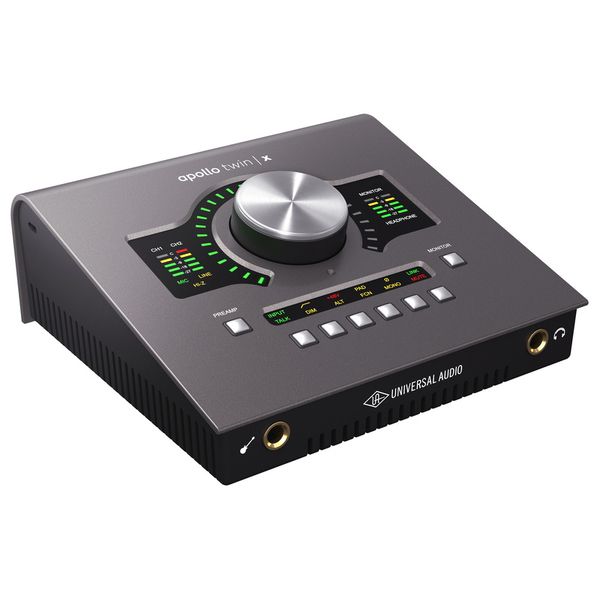If you’ve spent any time in music production communities, the Universal Audio Apollo Twin X has likely come up more than once. This compact interface has become a go-to choice for producers, engineers, and artists, bridging the gap between home studios and professional facilities.
Known for its world-class conversion, Unison™ mic preamps, and onboard UAD processing, the Twin X doesn’t just handle recording — it elevates it.
Whether you’re tracking vocals, mixing down a session, or running DSP-heavy plugins in real time, the Apollo Twin X has earned its reputation as one of the most reliable and sonically impressive interfaces on the market.
⭐⭐⭐⭐☆ (9.0/10) • Approx. $999.99

Sound Quality
The Apollo Twin X delivers pristine A/D and D/A conversion at up to 24-bit/192kHz, ensuring every detail of your recordings is captured with clarity and accuracy. Vocals and instruments come through with a natural warmth, wide stereo image, and plenty of headroom, making it easy to achieve mixes that feel open and dynamic.
What truly sets the Twin X apart is how it pairs with UAD’s Unison™ preamp emulations. From classic Neve and API tones to crisp modern clean gain, you can track through authentic analog character in real time.
The result is a polished, professional sound that rivals the quality of a full studio rack — all from a compact desktop interface.
Build & Design
The Apollo Twin X is built like a tank, with a solid metal chassis that feels premium the moment you set it on your desk. The brushed aluminum finish gives it a professional look, while the sloped desktop layout makes the controls easy to see and reach during a session.
The large volume knob is smooth, precise, and responsive, giving you fine control over monitoring levels without any wobble. Every button and switch has a sturdy, tactile feel, reassuring you that this unit is designed for years of daily studio use.
Combined with its compact footprint, the Twin X strikes the perfect balance between durability, portability, and desktop elegance.
Features
- 2 Unison-enabled mic preamps
- Real-time UAD plugin processing (low latency tracking with effects)
- Up to 10×10 simultaneous in/out (with ADAT expansion)
- Thunderbolt 3 connection for ultra-low latency
Price & Value
The Apollo Twin X typically retails between $899 and $1,299, depending on whether you choose the DUO or QUAD Core model.
While it’s a significant step up in price from entry-level interfaces, the Twin X delivers unmatched preamp quality, onboard UAD plugin processing, and rock-solid build.
Competing with options like the Antelope Zen Go and Apogee Symphony Desktop, the Apollo Twin X stands out for its balance of professional studio performance and compact design, making it a long-term investment for serious producers.
Pros
- Amazing sound quality
- Legendary UAD plugin suite
- Rugged build quality
- Real-time tracking with zero-latency effects
Cons
- Pricey compared to other 2-channel interfaces
- UAD plugins are powerful but can get expensive
- Limited I/O unless expanded
Verdict
The Apollo Twin X isn’t the cheapest interface on the market, but if you’re serious about your sound, it’s one of the best investments you can make. From the preamps to the plugin ecosystem, it’s built for producers who want professional quality without filling an entire rack.
Beyond the specs, it’s the kind of interface that grows with you — equally at home in a compact bedroom setup or as the centerpiece of a professional studio.
Its reliability, intuitive workflow, and access to world-class UAD plugins make it a tool you won’t outgrow anytime soon, ensuring long-term value well beyond its initial cost.
Rating: 9/10 — A studio-grade interface in a desktop-friendly size.
FAQ
Is the Apollo Twin X worth it for home studios?
Yes — while it’s a premium interface, the Apollo Twin X delivers world-class preamps, onboard UAD-2 processing, and ultra-low latency monitoring. For producers serious about pro-level recording and mixing, it’s one of the best options available.
Do I need UAD plugins to use the Apollo Twin X?
No — you can use the Apollo Twin X with any DAW and plugins. However, one of its main advantages is access to Universal Audio’s UAD plugin library, which runs directly on the interface’s DSP for zero-latency performance.
What are the main differences between the Apollo Twin X Duo and Quad?
The Duo has 2 DSP cores, while the Quad has 4. More cores mean you can run more UAD plugins simultaneously. If you plan on mixing with many UAD effects, the Quad offers more headroom.
Can the Apollo Twin X power professional studio monitors?
Yes — its high-quality line outputs can drive professional monitors with clean, accurate sound. Many producers use it as the centerpiece of their monitoring chain.
Is the Apollo Twin X compatible with Windows as well as Mac?
Yes — it works with both, but setup differs slightly. On Windows, you’ll need Thunderbolt 3 compatibility and proper drivers. On Mac, it integrates smoothly with macOS via Thunderbolt.
Who should buy the Apollo Twin X?
It’s best for producers, engineers, and artists who want professional-grade recording quality, plan to use UAD plugins, and need a reliable interface that can grow with their studio setup.
Looking for more options? Return to our Audio Interfaces Reviews Hub

Leave a Reply